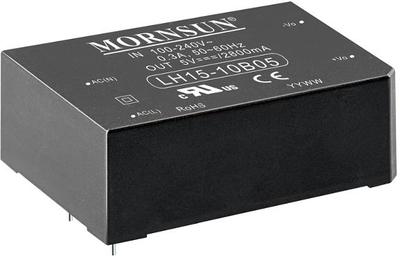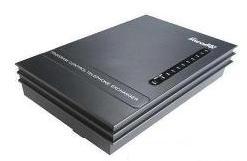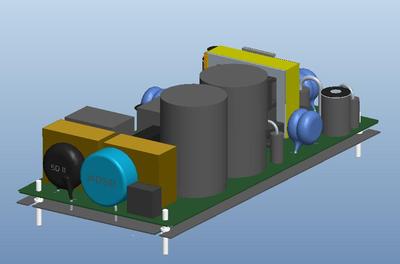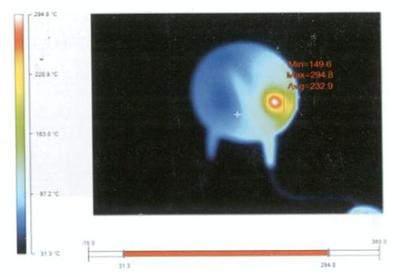EMC design technology based on power supply
Tuesday, 02 April, 2013
The rapid development of electronic technologies, particularly in the last decade, has brought to us a host of conveniences; however, electromagnetic couplings used in power supplies and various kinds of electronic equipment have become one of the major problems facing engineers today. The world is increasingly concerned about environmental pollution problems, which are now prominently included in many governments’ agenda’s. Electromagnetic pollution is now considered a part of this.
This article introduces how you might implement design ideas and design methods of power supplies which are essentially the energy heart of every system, encompassing the whole machine and its electromagnetic compatibility problems.
Foreword
When electronic equipment is in normal operation, it can produce all kinds of EMI, including interference from its internal components and interference from other surrounding electronic equipment. Similarly, it can cause interference to other electronic equipment as well. Thus, the requirement needed by electronic equipment in different applications (residential, industrial control, electric power) can vary greatly from one environment to the next. One can refer to the universal standard IEC/EN61000-6 series or the corresponding product industry requirements for more details.
There are mainly two aspects in the transmission of EMI:
- Transmission along the wires that mainly include transmissions along power supply ports and signal ports.
- Transmitted energy or radiated interference.
This article discusses interference suppression measures and the design of power supply ports.
EMI
Power supplies and products must conform to the corresponding lowest EMI emission energy requirements in their application environment. Otherwise, they will cause interference to surrounding equipment. The IEC/EN61000-6 standard is divided into industrial environment equipment and transmission requirements for residential, commercial and light industrial environments, according to requirements for general power supply products. In the early design stage of a general product like a power supply, the index positioning of EMI emissions will be designed as per the requirements of IEC/EN61000-6-3 or IEC/EN61000-6-4, unless specified otherwise for specific applications.
With the continuous miniaturisation of the size of power supply products and the constant increase of power density, the difficulty of EMI design for power supply itself has increased correspondingly. At present, all the Mornsun AC-DC products have not only been designed with built-in filters, but Mornsun has also invested a lot of design effort in the aspect of transformer shielding and power equipment noise absorption so as to satisfy the promised index requirements. All of the latest R2 mini-watt DC-DC products adopt a six-sided shielding structure in terms of design, which meets EN55022/CISPR 22, EN55011/CISPR 11 Class A requirements in the industry and also conforms to the level requirements of the foundational industry.
Even though Mornsun has invested design effort in power supply EMI suppression and provided products in line with a commitment of each index requirement, inevitably there are still some EMI issues occurring in some of the market’s applications. Many design engineers may think the root cause of the problem lies in the power supply, when in fact there are a number of misunderstandings regarding this point.
Because EMI conduction disturbance test projects mainly focus on power ports, the power port will become its transmission path. All EMI will go through the power supply port and reach the equipment under test. However, EMI analysed by test equipment does not only come from the power supply itself; the main part of interference also includes those caused by other components in the system, as well as the resonant EMI caused by parasitic parameters inside equipment.
All these types of EMI will reach the test equipment through power port coupling and the filters inside power supply are unable to realise the filtering effect on this portion of EMI. In power supplies many of the application environments can differ; all the filter components in the power supply designed are to solve their own inherent interferences in priority conditions and, at the same time, they reserve the biggest possible allowance in terms of attenuation characteristics and frequency spectrum characteristics.
However, compatibility may still be unable to suit every application. So when designing front-end power, it is required that the design engineers who are responsible for the whole system design must do circuit design by following the application circuits recommended by corresponding manufacturers.
Refer to the EMI problems which occurred in the actual application of Mornsun product LH15 EMI:


The above chart shows the conducted EMI emission test result of Mornsun product LH15-10 B05. This conforms to the requirement of EN55022/CISPR22 Class B, with sufficient allowance.


The above chart shows the whole system conducted EMI emission test result after Mornsun’s product LH15-10 B05 is used in a branded product. The result cannot meet the requirements of the EN55022/CISPR22 Class B and hardly meets Class A, not to mention the design allowance.
So for the power supply, even if the design level of its internal EMI is high, there must be a certain allowance for the part in actual applications. For the actual parameters, please refer to corresponding parameters specifications of specific products.
EMS EMI
In addition to meeting the requirements of the electromagnetic interference mentioned above, power supply must also conform to the immunity requirements of its corresponding application environment. If it is unable to meet the minimum requirements of a specific environment it can be influenced by EMI caused by other equipment around it, causing anomalies such as damage or instability of output and so on, which can ultimately affect the normal operation of the whole machine.
For power supplies generally there is no specific standard requiring that the immunity performance must reach certain levels. It should refer to the industry standards when being applied to a specific industry; at the beginning of a design, there is no positioning concept of a specific industry and design engineers can only refer to the specific requirements of the generic class standard IEC/EN61000-6. The standard IEC/EN61000-6-1/2 is divided into immunity requirements of industrial environment equipment and of residential area, commercial area and light industrial environments. The AC-DC part of Mornsun power supply products has been designed according to the most stringent level of industrial type products so as to ensure the design allowance is sufficient. Currently this type of power supply is guaranteed with level 4 index 2 kV (differential mode)/4 kV (common mode) protection capability and the port protection varistors in the internal design are identified with 14D specifications (see image below).

Through the table below we can clearly see the specification of 14D that its continuous surge current can reach 4.5 kA, and the promised index is only 1 kA (differential mode)/333A (common mode). From this contrast, it is clear that Mornsun’s derating range design is already a very big difference.
| Model | 561KD07 | 561KD10 | 561KD14 | 561KD20 |
| Maximum surge current | 1.75 kA | 3.5 kA | 6 kA | 10 kA |
| Continuous surge current | 1.2 kA | 2.5 kA | 2.5 kA | 6.5 kA |
However, usually during the market application process, the varistors in Mornsun products can be found damaged, which results in the varistor being burned. After investigation, there are basically two aspects of factors causing this. On one hand it is due to the ageing problem of the varistors, as can be seen with the most commonly used ZnO varistor in the market. The middle part of it is the insulation layer consisting of ZnO particles; the two side poles of it are formed by silver plating. When the voltage of both side poles exceeds its threshold voltage, the leakage current increases sharply, eventually forming a transient current discharge and triggering the protection effect for which it was designed.
Varistors make a current discharge when a transient surge pulse happens and exceeds certain parameters, and the characteristic of the varistor’s medium ZnO will change after current discharges many times, causing the device to deplete. So the residual voltage characteristic and discharge capacity of the varistor will be greatly reduced. The more serious problem is that the two-sided silver-plated structure of the varistor is unable to achieve 100% distribution over the silver-plated surfaces. This means it is inevitable that at some point the varistor’s surface will break over first, after suffering repeated shocks from surge pulses; naturally it gets burned first, resulting in total failure of the varistors eventually (see image below).

Varistors also make current discharge via the breakdown points, which will generate substantial heat in the discharge points. This heat will eventually lead to a burn through of varistors (see image below).

Another damaging factor is due to the misuse of the product by users. As explained above, misuse may lead to excessive EMI problems and can also affect EMS EMI seriously. The users’ applications differ greatly, thus the non-isolated applications of Mornsun AC-DC mini-watt isolated modules could lead to damage of the power supply. Even if the power supply is lucky enough to survive in such transient surge, there still will be a variety of anomalies in the back-end load parts. This has become a substantial problem for design engineers of the whole machine.

Problems caused by non-isolated application of an isolated power supply
Firstly, when we carry out common-mode surge tests, the surge between common-mode wire and GND will become the withstand voltage between the primary and secondary edges of the isolation power modules. For application environments with extremely harsh requirements on product reliability, such as electrical, railway transportation, etc, the tests will be carried out as per 4 kV surge level between the wire and GND. Most industries have designed the isolation value of power supplies following the 3 kV requirement or even lower, so these power supplies are inescapable from being damaged easily. It is only in special industries like the medical industry where the isolation value must be designed at 4 kV, sacrificing size and cost.
The second question is that when there are various kinds of disordered interference signals like transient pulses in the input port, isolated power supplies can easily protect the back-end load. But when applying isolated power supply modules in non-isolated applications, all interference signals from the input end will remain intact and be transmitted to load end, resulting in abnormalities or even paralysis of the whole system.
The application above is usually queried and considered for various reasons. Usually, by copying or looking at machine designs of some international famous brands as an example, we will be told that there are many applications like this in the market; of course, such situations exist. So under what conditions will this work normally and not cause any abnormal problems?
In regions where there are very well-developed power supply systems, their power grids are already very reliable, and when the EMI, loaded by the grids, are at a very positive situation, there isn’t any problem at all. On the other hand, in a situation where a lot of design effort and costs have been invested in the application so as to avoid transient interference at the input end, there won’t be an abnormality in the non-isolated application.
So generally from the point of reliability, this kind of design is not recommended and should be avoided.
Conclusion
The EMC design of the whole machine is a systematic project which needs us to fully and carefully review the index positioning and application environment in the early design phase and to review circuit diagrams, selection of raw materials, PCB layout drawing, physical design and process installation and so on during the design process.
Every single imperfection in the design element may lead to the failure of the whole design and a heavy price will be needed to pay in order to the make up for the defects.
References
- IEC 61000-6-1-2005 Immunity Standards of General Standard residential, commercial and light industrial environments
- IEC 61000-6-2-2005 Immunity Standards of the general industrial environments
- IEC 61000-6-3-2007 Emission standards of General Standard residential, commercial and light industrial environments
- IEC 61000-6-4-2007 Emission standards of General standard industrial environments
- CISPR 22-2005 Radio disturbance limits and measurement methods of Information technology equipment
Memristor-based hardware to advance AI
A researcher from UMass Amherst is developing memristor-based hardware technology with the...
5G satellite tech advances global mobile connectivity
A global team has showcased new 5G satellite technology linking Singapore and Japan, enabling...
Can AI speed up critical communications chip design?
A team led by researchers from the University of Texas at Austin plans to add AI into the design...






